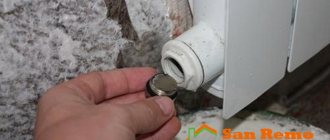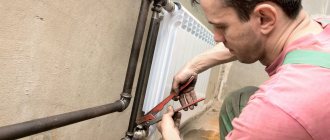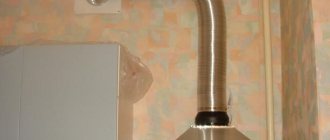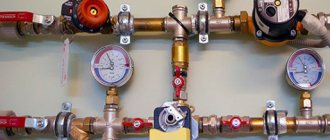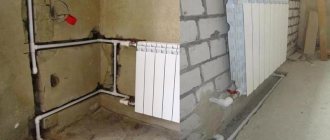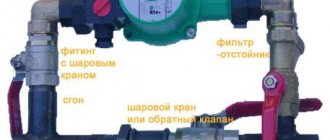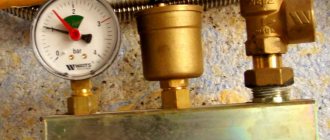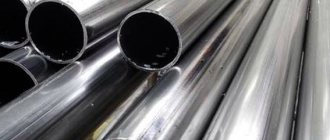Common causes of noise
Since in most cases, pipelines and radiators in houses are made of metal, which is a good conductor of sound, the source of noise in the heating pipe can be quite far away. Most often the problem is that the equipment is not being used correctly.
The main reasons contributing to the appearance of extraneous sounds in heating systems in the form of knocking or vibration are:
- One of the pipeline elements is clogged.
- Severely worn structural parts.
- Violations of the rules for arrangement and operation of heating equipment.
- Presence of air pockets.
- Too weak or, on the contrary, too strong a pressure.
- There is a leak in the system.
- Due to a breakdown or incorrect selection, the pump makes noise.
- Errors were made when selecting the technical characteristics of the equipment.
- There is insufficient coolant volume in the system, so you can hear water flowing.
- Sound insulation is broken and building codes are not followed.
- The regulator is incorrectly selected.
- There is a significant pressure drop in the system.
- There is no room for a pipe passing through a wall to expand as it heats up.
When a knocking sound in heating pipes in an apartment resembles hitting metal, it usually occurs when the liquid moving through the pipeline is heating or cooling, and in this case you need to check the condition of the support brackets.
What leaks most often?
Fistulas primarily appear along the welded seams of electric-welded pipes. This is understandable. In all likelihood, you will not bother with this problem and contact the organization servicing your home to troubleshoot the problem. Some leaks can be fixed on your own. It is easy to tighten or fill the seal on a plug tap or valve yourself. How to do this - there are many videos and other manuals that talk about malfunctions of the corresponding taps and valves.
Threads often leak. Specifically, at the connection between the locknut and the coupling on the downstream side. There, you just need to slightly tighten the lock nut, or by blocking the risers - your riser and the steam riser, “give back” the lock nut a little (unwind it along the thread), re-wind the plumbing flax and re-tighten the lock nut securely.
And another very common source of leakage is drain plugs. What actually happens and why do the plugs start leaking? A mechanic or one of the residents goes down to the basement to dump his riser in order to drain it. For example, to replace radiators, and then going down to the basement, he simply forgets to take the winding with him - plumbing flax, fum tape or something else. And accordingly, he screws in this long-suffering plug simply along the thread, tightening it with force. Steel is not a very ductile metal, and it is impossible to seal the connection in this way. The plug "whistles".
After some time, such fistulas usually become clogged, because the process water in the heating system contains a lot of suspended matter and silt. For some time, the plug will be a source of noise in the radiators and heating pipes. And naturally it will splash around, filling your basement with steam. Rewinding it is also easy. It is enough to close your riser together with the pair to it, in the case of lower filling, or at the upper filling, close one riser from below and from above in the attic, “give” the plug, wind it up and screw it in again.
Noise in radiators
To correctly diagnose the causes of noise in the battery, you should make sure that it is in normal technical condition. Often, when inspecting the radiator, damage is discovered. In this case, it should be repaired or replaced with a new device. If there is no obvious damage, it is necessary to determine the type of noise. Most often you can hear a hum and/or clicking noise in the radiator.
Their causes include the following common problems:
- Incorrectly installed battery.
- When moving, the water flow transmits vibration to the radiator, which in turn transmits vibration to the mounting units located in the wall.
- There is a foreign object inside the device. Often, once it gets into the system, it settles in the battery. Either this item was there initially and was not removed during installation.
- Air has entered the radiator. This causes the noise of flowing coolant or hum to appear in it.
- Incorrect functioning of the thermostat. The reason for this is the displacement of the shut-off rod.
You need to start fixing problems only after correctly diagnosing them. If the cause of extraneous noise is in the central heating main, you must contact the management company. When extraneous sounds are heard for a long time, you should call specialists to carry out diagnostics.
Flushing
The next scenario is flushing. If you hear a loud, uniform noise in your heating riser, if your radiators are noisy and this happens for several hours, perhaps one of your neighbors is simply flushing their radiator. In fact, flushing usually takes from 10 to 20 minutes, but most residents find that the longer the battery is flushed, the better it will perform in the future. Therefore, the noise may linger.
Battery during cleaning
Flushing is performed in order to remove blockages from the outer sections. They silt over time due to the slow flow of water into them. Flushing involves connecting a regular hose to the faucet instead of the lower radiator plug, which is directed to the toilet, sink, or bathtub. And through this tap and hose a certain amount of water is simply discharged. The silt that has accumulated here in the outer sections, if it has not yet petrified, flies out along with this water.
Quite exotic cases also happen. It's probably worth mentioning this. When the residents warmed themselves in this way, the radiator stood on the return side and, accordingly, heated rather weakly. The apartment owners found a simple way out of the situation - they set the riser to discharge. They shut off the valve on their riser below, below the radiator, and connected a hose, directed it into the toilet and thus used the discharge battery. This did help them survive the extreme cold that year, but naturally all the neighbors in this case enjoyed the noise from the radiators.
Presence of noise in the heating system pipes
When noise is detected, especially if heating pipes are cracking and there is a hum, the reasons may be complex.
It is quite difficult to immediately understand the sources of sounds, since they can overlap:
- If there are clicks in the heating pipes, they are often caused by a blockage that has formed in the system. Most likely, the lumen of the pipeline has narrowed and following this, in a separate section of it, the pressure becomes higher, then it drops, and the presence of such a difference makes itself known.
- In the case when heating pipes crack in a private house, the malfunction is associated with the air valve. It should be checked and, if necessary, replaced with a new product.
- When the pipe vibrates, then an error was made during installation of the system, and it may hit the wall. If a problem is detected inside the structure, it needs to be flushed to solve it. If the cause of vibration is located outside the pipeline, additional absorbers and fasteners should be installed. If there is a problem with the pumping equipment or mixer, they are either repaired or replaced.
Cranebox noise
This mechanism of noise generation is in the lead by a huge margin: in four cases out of five, the source of sound is the tap on hot or cold water.
Symptoms
A low-frequency hum occurs periodically (when a hot water supply or hot water tap is opened) and is accompanied by vibration of the riser and supply line.
Cause
The runout of a screw valve in a turbulent water flow. The valve and gasket, being in a certain position relative to the axlebox seat, close the seat at intervals of a fraction of a second and return to the initial position. The resulting series of water hammers is perceived as noise.
Sound source - screw valve with a movable valve
Please note: the problem is specific only to screw-type crane boxes. In the author's memory, ceramic axle boxes have never suffered from this disease: they simply do not have a valve that creates water hammer.
Ceramic taps, unlike screw ones, never make noise
Elimination
- Turn off the water (at home or in the apartment that is the source of noise);
Hint: simple communication with neighbors will help you find the owners of a noisy faucet. Low-frequency noise is difficult to position: trying to listen to the hum of a riser will not help you.
- Remove the lamb from the tap;
- Unscrew the faucet from the mixer body;
- Depending on the condition of the gasket, replace it or chamfer the edge of the gasket using sharp scissors. It is the edge protruding beyond the valve that causes turbulence in the water flow;
The crushed edge of the gasket causes turbulence in the water flow
- Place the faucet in place, turn on the water and make sure there is no noise by opening and closing the faucet.
Replacing the rubber gasket on the crane box
Heating pump malfunction
If the radiator and pipes are working properly, and the cause of the problem is related to the pump, it should be diagnosed. Most often, noise is caused by a faulty rotor or impeller. The entire heating system suffers from this and its efficiency begins to drop. Repair or complete replacement of parts can solve the problem.
The noise from the circulation pump is sometimes caused by external reasons, for example, a voltage drop. As a result, imbalance occurs, synchronization is disrupted and the coolant begins to move unevenly. This causes noise to be heard both in the radiators and in the pipes. The diagnosis must be carried out by a specialist.
But in some cases, even during stable operation of the pump, noise and vibration occur, then you need to check:
- whether the equipment power corresponds to the initial calculation results. If not, then the coolant moves through the pipes either too slowly or too quickly and creates different types of noise;
- correct installation. First of all, you need to check the location of the rotor of the device. It must be in a strictly horizontal position.
Vibration compensators for heating
One of the solutions for noise insulation for pipes is the installation of a vibration compensator. If vibrations and water hammer are present in the system, then installing special flange elements will solve this problem. They absorb such mechanical costs and protect the system from unwanted stress.
In the case of a private house, the device is installed directly next to the pump. If the problem is in an apartment building, then vibration compensators are installed near the central riser from where water is supplied and near the wall partitions. Installation is not difficult; many people can do it on their own. Such sound insulation will absorb the main noise irritants that are transmitted through the pipes.
Extraneous sounds in heating boilers
Noises heard in heating boilers arise for the same reasons as in the case of pipes and radiators. Most likely, they appeared as a result of clogging of the heat exchanger due to lime deposits. The design feature of the unit plays an important role. If the problem is a clog, it needs to be removed. When cleaning does not help, you should further look for the cause of the problem, but the best solution would be to call a specialist.
When determining the noise problem in the boiler yourself, you should take into account the peculiarities of its design and the fuel used:
- Gas unit. Perhaps the whole point is that the burner is not functioning evenly. Such a problem as knocking in the gas pipe appears in already outdated boiler models that do not have additional control over the flame. In this case, it is advisable to update the device so that it meets modern standards.
- Solid fuel boiler. Extraneous sound may come from behind the chimney. As a result of prolonged use, it begins to become clogged and the traction force decreases. The chimney structure needs to be cleaned.
- Diesel appliance or apparatus operating during mining. A whistling noise is heard from the injector nozzle and should be cleaned.
It should be borne in mind that the cause of extraneous sounds may not be one fault, but several. Therefore, comprehensive diagnostics of the heating unit should be carried out.
Thermal expansion
In the author’s practice there was a rather curious and exotic case: the source of annoying noise turned out to be... the extension of a steel hot water riser when heated.
Symptoms
Short clicks with a frequency of several seconds, the source of which is the hot water riser.
Cause
In a dead-end DHW system (or in a circulation system in the absence of continuous circulation in the risers due to an airy jumper between them or an incorrect connection diagram), the temperature of the pipes is constantly changing. When drawing water, the riser heats up, and when there is no water drawing, it cools down.
Dead-end DHW wiring: water heats up only when it is disassembled
In full accordance with the laws of physics, pipes lengthen with each increase in temperature. If the riser touches the reinforcement in the floor panel, the friction of metal on metal will become a source of unpleasant sounds that occur without a clear periodicity.
Like any other material, steel expands when heated.
Solution
The noise is eliminated by removing the section of reinforcement touching the riser. The hole in the ceiling is sealed with cement-sand mortar.
To stop the noise, it is enough to remove the fittings from the riser
Why is the pump in the heating system noisy? Troubleshooting
To prevent malfunctions and breakdowns, it is advisable to choose the right type of pump. At sales points you can find two types of devices:
- With dry rotor. A pump of this type is required to control a heating network with a high load level. At the same time, the power unit remains dry due to insulating gaskets. To remove heat, an air cooling system is used, which will make noise during operation.
- Wet – the pump is located in liquid. Pumping occurs due to screws, and overheating does not occur due to the quiet heat carrier.
The appearance of a hum may be a consequence of the following problems:
- unstable voltage level;
- incorrect installation;
- the pipeline is clogged with dirt or air;
- insufficient or excessive power;
- equipment breakdown.
Unstable voltage
The circulation pump is powered from the mains. When electrical energy is supplied, by converting the current into mechanical energy, the rotor rotates and the flow of water through the pipeline is accelerated or slowed down. If the voltage is unstable, it will cause the RPM to increase or decrease. In this case, the circulation of the liquid is interrupted, and mechanical sounds may appear inside the radiators or pipes.
Horizontal installation
To find out the nature of the noise, it is necessary to carry out diagnostic measures that will allow you to find the cause of the problems. The procedures will require the involvement of professionals with diagnostic equipment.
Noise due to installation error
In this case, sounds similar to rustling occur. The reason for the appearance of excessive cavitation loads in the system. That is, too many gas bubbles forming and collapsing. In order to get rid of the problem, you will need to install a hydraulic compensator, which is a tank with a set of membranes that provides an auxiliary function during heating.
At the same time, static pressure is monitored. The device allows you to draw in an excess volume of liquid when heating and does not allow water hammer. With proper installation, the service life of the pump increases significantly.
The pump whistles due to air locks
During operation of the pump, especially when switching on and off, a large number of bubbles may form. Liquid penetration into the hollow spaces of pipes and radiators has a similar effect. At the same time, due to the forced acceleration of liquid through the pipes, a strong whistle occurs, which interferes with comfortable living.
Operation process
In order to get rid of it, you will have to use a design feature of the radiators or pump. Special Mayevsky valves are placed on the devices, which are structurally provided openings for air release. Locking is carried out by a screw plug, which is usually located at the top of the radiator.
Mismatch between parameters and power
Strong noise may occur due to the installation of an overly powerful unit to a particular system
When purchasing, you need to pay attention to all the parameters of the pumps, which are indicated on the packaging and in the instructions. Excessive power causes loud noise
If it is insufficient, problems may arise with the regulation of heat supply in the house.
A circulation pump for a private home becomes one of the purchases that needs to be made when the parameters of the rest of the equipment are known. When the number of radiators and the length of the pipes are already known to the owners, they can select a pump. The load should be calculated based on the average annual winter temperature outside.
The device hums and crackles due to breakdown
Common breakdowns that occur during the operation of heating equipment are defects in the power unit or impeller. At this time, a loud noise occurs, which significantly reduces the comfort of living next to such a unit. Also, the device will begin to work much worse and it will become difficult to regulate the operation of the system.
The reason for the hum is the increase in the size of the gaps required for rotation. At the same time, the shaft loosens, then strong unpleasant sounds appear. To get rid of the problem, you will have to replace or restore the adjusting components of the device.
Breaking
The windings of an electric motor transformer can cause crackling noise. This may cause the device to become very hot. Without specialized skills in restoring such units, it is better not to undertake repairs. The best choice would be to hire a professional.
